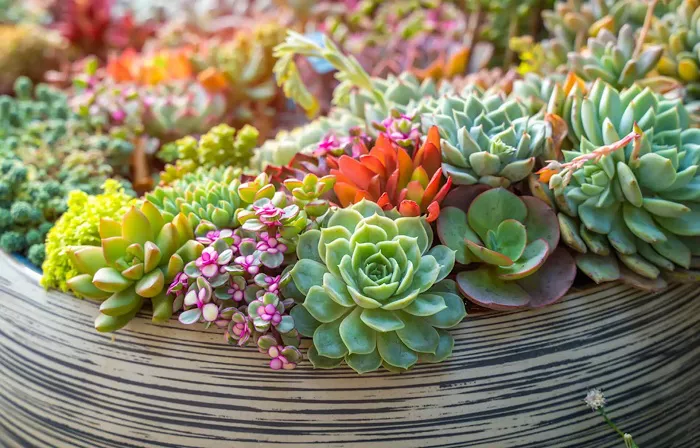Succulents are beloved for their unique shapes, vibrant colors, and low-maintenance nature. However, one of the most common questions gardeners ask is, “How often do I water my succulent?” The answer isn’t as straightforward as you might think. Succulents thrive on neglect, but they still need proper care to stay healthy. In this article, we’ll explore everything you need to know about watering succulents, from understanding their needs to avoiding common mistakes.
Understanding Succulent Water Needs
Succulents are native to arid environments, where water is scarce. Their thick, fleshy leaves and stems store water, allowing them to survive long periods of drought. This adaptation means they don’t need frequent watering like other plants. Overwatering is the most common cause of succulent death, as it leads to root rot and other issues. To keep your succulents thriving, it’s essential to mimic their natural habitat by providing just the right amount of water.
Factors That Affect Watering Frequency
Several factors influence how often you should water your succulents. Understanding these will help you create a tailored watering schedule.
1. Type of Succulent
Different succulents have different water needs. For example, cacti require less water than echeverias or sedums. Research your specific succulent species to determine its ideal watering routine.
2. Season
Succulents grow actively in spring and summer and enter dormancy in fall and winter. During active growth, they need more water. In dormancy, reduce watering significantly to prevent overhydration.
3. Climate
Hot, dry climates will dry out soil faster, requiring more frequent watering. In humid climates, succulents need less water because the air retains moisture.
4. Pot Size and Material
Small pots dry out faster than large ones. Porous materials like terracotta allow soil to dry more quickly, while plastic or glazed pots retain moisture longer.
5. Soil Type
Well-draining soil is crucial for succulents. A mix of potting soil, sand, and perlite ensures excess water drains away, preventing root rot.
How to Water Succulents Correctly
Watering succulents isn’t just about frequency; it’s also about technique. Here’s how to do it right:
1. The Soak-and-Dry Method
This is the most effective way to water succulents. Thoroughly soak the soil until water drains out of the pot’s bottom. Then, let the soil dry completely before watering again. This method mimics the natural rainfall patterns succulents experience in the wild.
2. Avoid Light Watering
Light watering only moistens the surface, encouraging shallow root growth. Deep watering promotes healthy, robust roots.
3. Check the Soil
Before watering, check the soil’s moisture level. Stick your finger about an inch into the soil. If it feels dry, it’s time to water. If it’s still moist, wait a few more days.
4. Water in the Morning
Watering in the morning allows excess moisture to evaporate during the day, reducing the risk of fungal diseases.
Signs Your Succulent Needs Water
Succulents are excellent at communicating their needs. Look for these signs to determine when to water:
Wrinkled or Shriveled Leaves: This indicates the plant is using its stored water and needs a drink.
Dry, Cracked Soil: If the soil pulls away from the pot’s edges, it’s too dry.
Slow Growth: Underwatered succulents may stop growing or produce smaller leaves.
Signs of Overwatering
Overwatering is more dangerous than underwatering. Watch for these warning signs:
Yellowing or Translucent Leaves: This means the cells are bursting from too much water.
Mushy Stems or Leaves: A sign of rot, often caused by excess moisture.
Foul Odor: Rotting roots or stems can produce a bad smell.
Creating a Watering Schedule
While succulents don’t thrive on strict schedules, having a general guideline can help. Here’s a basic framework:
Spring and Summer: Water every 7-10 days, depending on the climate and soil dryness.
Fall and Winter: Water every 2-4 weeks, or even less if the plant is dormant.
Remember, these are just starting points. Always adjust based on your succulent’s specific needs and environmental conditions.
Tips for Healthy Succulents
Beyond watering, here are some additional tips to keep your succulents thriving:
Use the Right Soil: A well-draining mix is essential. Avoid regular potting soil, which retains too much moisture.
Provide Adequate Light: Succulents need plenty of sunlight. Place them near a sunny window or under grow lights.
Ensure Proper Drainage: Always use pots with drainage holes to prevent water from pooling at the bottom.
Rotate Your Plants: Rotate succulents regularly to ensure even light exposure and balanced growth.
Monitor for Pests: Keep an eye out for common pests like mealybugs and spider mites, which can harm your plants.
Common Mistakes to Avoid
Even experienced gardeners can make mistakes with succulents. Here are some pitfalls to watch out for:
Overwatering: This is the number one killer of succulents. Always err on the side of underwatering.
Using the Wrong Soil: Heavy, moisture-retentive soil can lead to root rot.
Ignoring Seasonal Changes: Adjust your watering routine to match the plant’s growth cycle.
Crowding Plants: Overcrowding can trap moisture and increase the risk of disease.
Frequently Asked Questions
1. Can I Use a Spray Bottle to Water My Succulents?
No. Spray bottles only moisten the surface, which isn’t enough for succulents. Use the soak-and-dry method instead.
2. How Do I Know If My Succulent Is Dormant?
Dormant succulents stop growing and may lose some leaves. Research your specific species to understand its dormancy period.
3. Can I Save an Overwatered Succulent?
Yes, if caught early. Remove the plant from its pot, trim any rotten roots, and let it dry out before repotting in fresh soil.
4. Do Succulents Need Fertilizer?
Yes, but sparingly. Use a diluted, balanced fertilizer during the growing season.
Conclusion
Watering succulents doesn’t have to be complicated. By understanding their natural habitat and adapting your care routine, you can keep these resilient plants thriving. Remember, less is often more when it comes to watering. With the right balance of light, soil, and water, your succulents will reward you with their stunning beauty and unique charm. Happy gardening!


